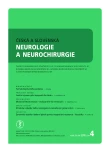Dynamic Magnetic Resonance Imaging of a Lumbar Spine – a Case Report
Authors:
P. Kolář 1; J. Štulík 2; M. Kynčl 3
Authors place of work:
FN v Motole, Praha
Klinika rehabilitace a tělovýchovného lékařství 2. LF UK v Praze
1; FN v Motole, Praha
Oddělení spondylochirurgie
2; FN v Motole, Praha
Klinika zobrazovacích metod 2. LF UK v Praze
3
Published in the journal:
Cesk Slov Neurol N 2010; 73/106(4): 438-442
Category:
Kazuistika
Summary
Patients with vertebrogenic problems are usually examined by magnetic resonance imaging (MRI) in the stationary, relaxed supine position only. This position, however, does not allow sufficient evaluation of morphological findings since these may vary under different postural, spine-loading situations. This has been confirmed by MRI assessment with the patient standing or by dynamic MRI assessment with the patient bending forwards or backwards. At this time, there is no MRI device in the Czech Republic that permits assessment with the patient standing or bending, so we perform MRI assessment while inducing stabilizing muscle activity. For lumbar spine evaluation, MRI analysis at the same time as hip flexion against some small resistance or just gravity proves to be spine-loading and therefore dynamic, since the patient needs to activate not only hip flexors, but also spinal stabilizers. Such an MRI assessment allows for intradiscal movement, shape measurement, and a degree of stability, allowing regional anatomical parameter measurements and analysis of disc/nerve root relationships during dynamic postural loading. Disturbed function of soft tissue structures in response to various postural situations may result in discrepancies between subjective symptoms, neurological signs, and morphological findings arising out of the static supine position. Stability analysis by means of dynamic MRI studies may also assist in determining the optimum surgical procedure for any given patient.
Key words:
vertebrogenic syndromes – postural function – dynamic magnetic resonance imaging
Zdroje
1. Allat JP. Low back pain, sciatica and lumbar intervertebral disc herniation. Rheumatology 1994; 23(2): 55–57.
2. Kulig K, Landel R, Powers CM. Assessment of lumbar spine kinematics using dynamic MRI: a proposed mechanism of sagittal plane motion induced by manual posterior-to-anterior mobilization. J Orthop Sports Phys Ther 2004; 34(2): 57–64.
3. McGregor AH, Anderton L, Gedroyc WM, Johnson J, Hughes SP. The use of interventional open MRI to assess the kinematics of the lumbar spine in patients with spondylolisthesis. Spine 2002; 27(14): 1582–1586.
4. Hodges PW, Gandevia SC. Changes in intra-abdominal pressure during postural and respiratory activation of the human diaphragm. J Appl Physiol 2000; 89(3): 967–976.
5. Hodges PW, Richardson CA. Feedforward contraction of transversus abdominis in not influenced by the direction of arm movement. Exp Brain Res 1997; 114(2): 362–370.
6. Sapsford R. Rehabilitation of the pelvic floor muscles utilizing trunk stabilization. Man Ther 2004; 9(1): 3–12.
7. Schwarzenbach O, Berlemann U, Stoll TM, Dubios G. Posterior dynamic stabilization system: DYNESYS. Orthop Clin North Am 2005; 36(3): 363–372.
8. Kanayama M, Togawa D, Hashimoto T, Shigenobu K, Oha F. Motion-preserving surgery can prevent early breakdown of adjacent segments: comparison of posterior dynamic stabilization with spinal fusion. J Spinal Disord Tech 2009; 22(7): 463–467.
9. Bothmann M, Kast E, Boldt GJ, Oberle J. Dynesys fixation for lumbar spine degeneration. Neurosurg Rev 2008; 31(2): 189–196.
10. Modic TM, Ross JS. Magnetic resonance imaging in the evaluation of low back pain. Orthop Clin North Am 1991; 22(2): 283–301.
Štítky
Dětská neurologie Neurochirurgie NeurologieČlánek vyšel v časopise
Česká a slovenská neurologie a neurochirurgie

2010 Číslo 4
- Metamizol jako analgetikum první volby: kdy, pro koho, jak a proč?
- Nejčastější nežádoucí účinky venlafaxinu během terapie odeznívají
- Pregabalin je účinné léčivo s příznivým bezpečnostním profilem pro pacienty s neuropatickou bolestí
- Moje zkušenosti s Magnosolvem podávaným pacientům jako profylaxe migrény a u pacientů s diagnostikovanou spazmofilní tetanií i při normomagnezémii - MUDr. Dana Pecharová, neurolog
Nejčtenější v tomto čísle
- Dynamické vyšetření bederní páteře pomocí magnetické rezonance – kazuistika
- Farmakologická léčba epilepsie
- Léčba juxtafacetární cysty bederní páteře dynamickou interspinózní stabilizací – kazuistika
- Funkční význam pólu temporálního laloku
